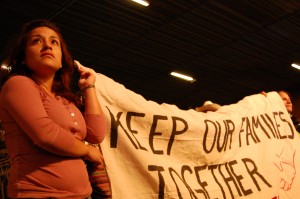
A woman holds a sign at a rally held in downtown Phoenix in opposition to Arizona's new immigration law.
Last year, when we chose Latino and Borderlands issues as our focus for ASU News21, we knew we were setting out to tackle a timely and important topic. We also felt we were uniquely positioned to provide quality coverage. These issues have long been a focus and interest of the university and the Cronkite School of Journalism.
We did not know that in 2010 we would find ourselves at ground zero of an explosive national debate over immigration. The Arizona State Capitol, scene of dramatic protests and rallies surrounding the controversial immigration law known as SB 1070, is just blocks from our newsroom. In recent weeks we’ve been able to look out our windows onto Phoenix’s Downtown Civic Space to watch yet more protests and parades in reaction to the law. The chief proponents and opponents of the law are figures well-known to our reporting team. They’ve followed them, interviewed them, and closely studied their principles and motivations.
Now, as the rhetoric remains heated and the legal and political landscape continues to shift, we’ve decided to delve into these issues anew — in the News21 way. We’re going in-depth to find interesting, original stories and vital but often overlooked information that will help to truly inform the debate. We will present those stories in new ways and invite our audience to join civil discussions about these topics.
* We’ll delve into the plight of citizen children of undocumented immigrants and look at why they are the next target of hardline policy-makers. We will consider what it is like for children to be left alone — sometimes for years — when their parents are deported.
* As undocumented children grow up in the United States, attend school, and try to find work, they face major challenges. Many of them consider themselves American in every sense of the word. Some are accomplished enough to enter college. Throughout the country these college students face a patchwork of state laws — some accommodating and some hostile — that affect their status and ability to pay for school.
* Crime is often cited as one of the top concerns of those who support a crackdown on illegal immigration. Do undocumented immigrants commit more crimes than others and are crime rates changed by waves of immigration? We will explore various communities’ experience illegal immigration in an attempt to understand this complex issue.
* We’ll investigate programs aimed at deterring border crossers through swift but arbitrary — and sometimes confusing — court proceedings and/or deportation to remote areas. Lawmakers are calling for the expansion of these programs but saying little about the cost or commitment involved. We’ll investigate what expansion of the programs might mean for taxpayers, government agencies, and the communities along the border.
* We’ll consider what happens to families left behind when immigrants die or disappear — and how authorities on both sides of the border work to identify the dead and inform relatives of their fate.
* We’ll explore the experience of immigrant women and investigate why they are more likely to die while crossing the border, more likely to face discrimination on the job, and more likely to face abuse when detained. We’ll ask hard questions about who is responsible for the harrowing experiences these women confront.
* Nearly all immigrants come to the United States looking for work and most of them find it. The demand for cheap labor on the part of businesses and the desire for wages by immigrants drives the flow of people. Experts have said if immigration is to be curtailed, American employers will have to stop hiring undocumented workers. We will look at states that have serious penalties for those who knowingly employ undocumented immigrants and those that don’t. Readers might be surprised at what we find.
* As some states and communities have moved to make undocumented immigrants unwelcome, others have openly embraced them. We will explore these so-called “sanctuary” communities to learn why they are moving in the opposite direction of so many other locations in the country.
* As the debate rages on this side of the border what is going on in Mexico? How are people living their lives and how are local, state, and federal officials dealing with the violence related to the drug trade? What do they think of the crackdown on illegal immigration in the United States?
Stay tuned.

